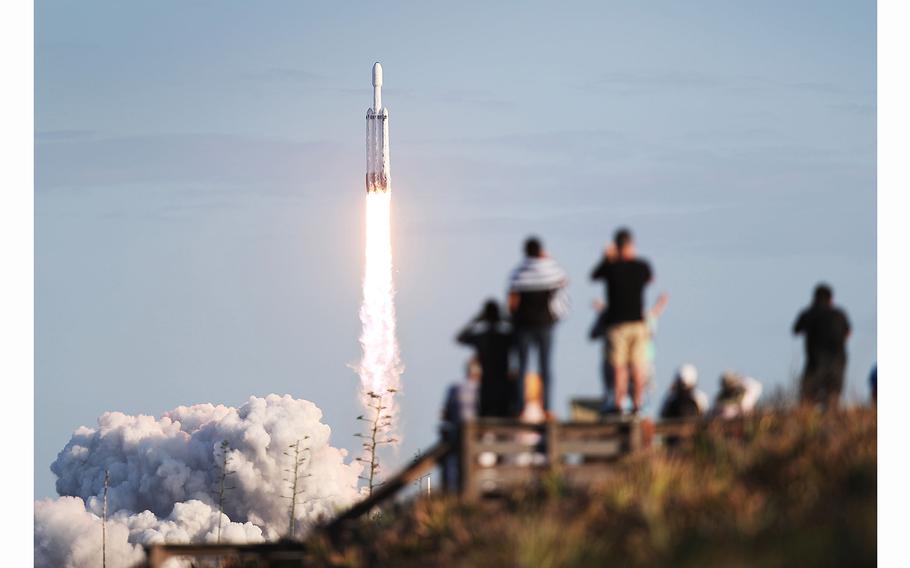
People watch as the SpaceX Falcon Heavy rocket lifts off from launch pad 39A at NASA’s Kennedy Space Center on April 11, 2019, in Titusville, Fla. (Joe Raedle/Getty Images/TNS)
ORLANDO, Fla. (Tribune News Service) — There’s no chance SpaceX or United Launch Alliance will accidentally hit Santa Claus with their big rockets over Christmas as both companies have delayed the next launches of the Falcon Heavy and Vulcan Centaur.
SpaceX announced it would target no earlier than Dec. 28 for the launch of its powerhouse Falcon Heavy that came within an hour of liftoff this past week at Kennedy Space Center’s Launch Pad 39-A, but a “ground side issue” and then horrible weather conditions forced a scrub and further delays.
The new launch target for the USSF-52 mission for the Space Force falls within a four-hour window that opens at 7 p.m. on the Thursday between the Christmas and New Year’s weekends. Its payload is Boeing’s X-37B Orbital Test Vehicle, the secretive spacecraft making its seventh trip to orbit for what’s expected to be a yearslong mission in space.
Falcon Heavy, making its ninth launch ever and fifth of the year, is essentially three Falcon 9’s strapped together that produce 5.1 million pounds of thrust on liftoff, the most powerful rocket in regular use. Its two side boosters will also attempt a recovery landing at nearby Cape Canaveral Space Force Station that produce a pair of double sonic booms that can be heard and felt on the Space Coast and deeper into Central Florida.
A second SpaceX rocket that has been repeatedly scrubbed because of weather may still launch this week from Canaveral’s Space Launch Complex 40 but SpaceX has yet to announce a new target launch for it.
United Launch Alliance had also been planning to send up its big new rocket, the Vulcan Centaur, before the end of the year, most recently targeting a Christmas Eve launch, but delays in a wet dress rehearsal last week forced ULA to reschedule any attempt until the new year.
ULA President and CEO Tory Bruno said the Certification-1 mission could fly during a four-day window that opens Jan. 8.
The replacement for ULA’s retiring Atlas V and Delta IV Heavy rockets is also more powerful than both with up to 4.1 million pounds of thrust on liftoff.
Its main payload is Astrobotic Technology’s Peregrine lunar lander, which could be the first of NASA’s spate of moon missions under its Commercial Lunar Payload Services contracts.
That’s already a busy launch window for the Space Coast with the first crewed launch of the year, the private Axiom Space mission of four crew on a two-week visit to the International Space Station, targeting a potential Jan. 9 launch atop a SpaceX Falcon 9 in the Crew Dragon Freedom.
That flight could come from either KSC or Cape Canaveral as SpaceX projects to have completed its new crew access arm at its Canaveral site.
SpaceX could be juggling launch pads as it’s tasked to send up another of NASA’s CLPS missions with a Jan. 12 launch of another Falcon 9 flying the Intuitive Machines’ IM-1 mission with its Nova-C lunar lander.
The Space Coast has seen a record 68 orbital launches so far in 2023 with projections of close to 100 on tap for 2024.
©2023 Orlando Sentinel.
Visit orlandosentinel.com
Distributed by Tribune Content Agency, LLC.